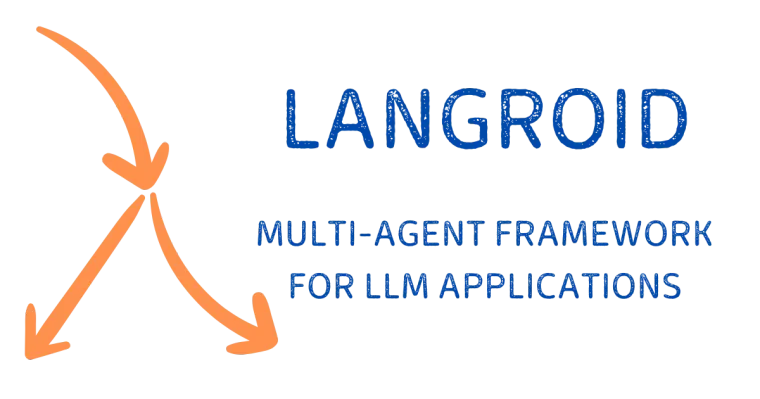In this era of Large Language Models (LLMs), there is unprecedented demand to create intelligent applications powered by this transformative technology. What is the best way for developers to harness the potential of LLMs in complex application scenarios?
For a variety of technical and practical reasons (context length limitations, LLM brittleness, latency, token costs), this is not as simple as throwing a task at an LLM system and expecting it to get done. What is needed is a principled programming framework, offering the right set of abstractions and primitives to make developers productive when building LLM applications.
Langroid’s Elegant Multi-Agent Paradigm
The Langroid team (ex-CMU/UW-Madison researchers) has a unique take on this — they have built an open-source Python framework to simplify LLM application development using a Multi-Agent Programming paradigm. Langroid’s architecture is founded on Agents as first-class citizens: they are message-transformers and accomplish tasks collaboratively via messages.
Langroid is emerging as a popular LLM framework; developers appreciate its clean design and intuitive, extensible architecture. Programming with Langroid is natural and even fun: you configure Agents and equip them with capabilities ( such as LLMs, vector databases, and Function-calling/tools), connect them, and have them collaborate via messages. This is a “Conversational Programming” paradigm and works with local/open and remote/proprietary LLMs. (Importantly, it does not use LangChain or any other existing LLM framework).

An Agent serves as a convenient abstraction, encapsulating the state of LLM conversations, access to vector stores, and various tools (functions or plugins). A Multi-Agent Programming framework naturally aligns with the demands of complex LLM-based applications.
Connecting Agents via Tasks
In Langroid, a ChatAgent has a set of “responder” methods, one for each “entity”: an LLM, a human, and a tool handler. However, it does not have any way to iterate through these responders. This is where the Task class comes in: A Task wraps an Agent and gives it the ability to loop through its responders via the Task.run() method.
A Task loop is organized around simple rules that govern when a responder is eligible to respond, what is considered a valid response, and when the task is complete. The simplest example of a Task loop is an interactive chat with the human user. A Task also enables an Agent to interact with other agents: other tasks can be added to a task as sub-tasks in a recursive, hierarchical (or DAG) structure. From a Task’s perspective, sub-tasks are just additional responders and present the same string-to-string message-transformation interface (function signature) as the Agent’s “native” responders. This is the key to the composability of tasks in Langroid since a sub-task can act the same way as an Agent’s “native” responders and is subject to the same rules of task orchestration. The result is that the same task orchestration mechanism seamlessly enables tool handling, retries when LLM deviates, and delegation to sub-tasks. More details are in the Langroid quick-start guide.
A Taste of Coding with Langroid
To get started with Langroid, simply install it from pypi into your virtual environment:
pip install langroid
To directly chat with an OpenAI LLM, define the LLM configuration, instantiate a language model object, and interact with it: (Langroid works with non-OpenAI local/proprietary LLMs as well, see their tutorial) For the examples below, ensure you have a file .env containing your OpenAI API key with this line: OPENAI_API_KEY=sk-....
The MDL does not maintain any conversation state; for that, you need a ChatAgent:
import langroid as lr
import langroid.language_models as lm
llm_cfg = lm.OpenAIGPTConfig() # default GPT4-Turbo
mdl = lm.OpenAIGPT(llm_cfg)
mdl.chat("What is 3+4?", max_tokens=10)agent_cfg = lr.ChatAgentConfig(llm=llm_cfg)
agent = lr.ChatAgent(agent_cfg)
agent.llm_response("What is the capital of China?")
agent.llm_response("What about France?") # interprets based on previous msgtask = lr.Task(agent, name="Bot")
task.run("Hello")Have a Teacher Agent talk to a Student Agent:
teacher = lr.ChatAgent(agent_cfg)
teacher_task = lr.Task(
teacher, name="Teacher",
system_message="""
Ask your student simple number-based questions, and give feedback.
Start with a question.
""",
)
student = lr.ChatAgent(agent_cfg)
student_task = lr.Task(
student, name="Student",
system_message="Concisely answer your teacher's questions."
)
teacher_task.add_sub_task(student_task)
teacher_task.run()Retrieval Augmented Generation (RAG) and Vector Databases
One of the most popular LLM applications is question-answering on documents via Retrieval-Augmented Generation (RAG), powered by a vector database. Langroid has a built-in DocChatAgent that incorporates several advanced RAG techniques, clearly laid out so they can be easily understood and extended.
Built-in Support for LanceDB

Langroid uses LanceDB as the default vector store for its DocChatAgent.
Langroid’s DocChatAgent uses the LanceDB serverless vector database by default. Since LanceDB uses file storage, it is easy to set up and use (no need for docker or cloud services), and due to its use of the Lance columnar format, it is highly performant and scalable. In addition, Langroid has a specialized LanceDocChatAgent that leverages LanceDB's unique features such as Full-text search, SQL-like filtering, and pandas dataframe interop. Setting up a basic RAG chatbot is as simple as (assume the previous imports):
from langroid.agent.special.lance_doc_chat_agent import import (
LanceDocChatAgent, DocChatAgentConfig
)
llm_config = lm.OpenAIGPTConfig()
rag_agent_config = DocChatAgentConfig(
llm=llm_config,
doc_paths=["/path/to/my/docs"], # files, folders, or URLs.
)
rag_agent = LanceDocChatAgent(rag_agent_config)
rag_task = lr.Task(rag_agent, name="RAG")
rag_task.run()📄Chat with IMDB movies dataset
For an example showcasing Tools/Function-calling + RAG in a multi-agent setup, see their quick-start Colab notebook which shows a 2-agent system where one agent is tasked with extracting structured information from a document and generates questions for the other agent to answer using RAG. In the Langroid-examples repo there is a script with the same functionality, and here is what it looks like in action:

Retrieval Augmented Analytics
One of the unique features of LanceDB is its SQL-like filtering and Pandas dataframe interoperability. LLMs are great at generating SQL queries, and also Pandas computation code such as df.groupby("col").mean(). This opens up a very interesting possibility, which we call Retrieval Augmented Analytics: Suppose a user has a large dataset of movie descriptions with metadata such as rating, year, and genre, and wants to ask:
What is the highest-rated Comedy movie about college students made after 2010?
It is not hard to imagine that an LLM should be able to generate a Query Plan to answer this, consisting of:
- A SQL-like filter:
genre = "Comedy" and year > 2010 - A Pandas computation:
df.loc[df["rating"].idxmax()] - A rephrased query given the filter: “Movie about college students” (used for semantic/lexical search)
Langroid’s Multi-Agent framework enables exactly this type of application. The LanceRAGTaskCreator takes a LanceDocChatAgent and adds two additional agents:
- QueryPlannerAgent: Generates the Query Plan
- QueryPlanCriticAgent: Critiques the Query Plan and Answer received from the RAG Agent so that the QueryPlanner can generate a better plan if needed.
Checkout the lance-rag-movies.py script in the langroid-examples repo to try this out.
Try it out and get involved!
This was just a glimpse of what you can do with Langroid and how your code would look. Give it a shot and learn more about the features and roadmap of Langroid on their GitHub repo. Langroid welcomes contributions, and they have a friendly Discord community.
If you like it, don’t forget to drop a 🌟.



